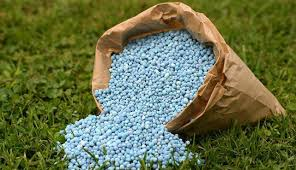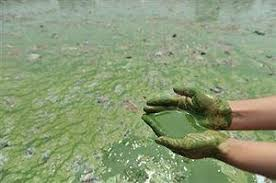Science > Biology > Management of Crop Production > Chemical Fertilizers
A fertilizer is a natural or synthetic, chemical-based substance containing one or more nutrients essential for enhancement of plant growth and soil fertility. Most of the chemical fertilizers used are NPK fertilizers which are rich in nitrogen (N), phosphorous (K), and potassium (K). Fertilizers may also add secondary nutrients such as sulphur, magnesium, and calcium to the soil or growing media.

Nitrogenous Fertilizers:
Nitrogenous fertilizers are the nitrogen-containing organic substances that supply the nutrition of nitrogen to the plants. They are of four types.
- Nitrate Fertilizers: e.g. Sodium nitrate.
- Ammonium Fertilizers: e.g. Ammonium sulphate.
- Nitrate and ammonium fertilizers: e.g. Ammonium sulphate.
- Amide fertilizers: e.g. Urea.
Phosphatic Fertilizers:
Phosphatic fertilizers are the phosphorous-containing organic substances that supply the nutrition of phosphorous to the plants.
- Calcium dihydrogen phosphate,
- Ammonium phosphate
- Ammonium hydrogen phosphate
Potassium Fertilizers:
Potassium fertilizers are the potassium-containing organic substances that supply the nutrition of potassium to the plants.
- Potassium chloride
- Potassium sulphate
- Potassium nitrate
Some Important Chemical Fertilizers
Ammonium sulphate [(NH4)2 S04]:
This is a nitrogenous fertilizer, which is used for raising the production level of crops like paddy, potato, etc. In this fertilizer there is nearly 25% ammonia which is converted into the nitrate by the denitrifying bacteria present in the alkaline soil. Nitrates are water-soluble and are easily absorbed by the plants from the soil.
Calcium Ammonium Nitrate [Ca (N03)2 NH4NO]:
This is a nitrogenous fertilizer which is directly absorbed by the plants. As it is directly absorbed by water, there is no question of pollution with this fertilizer.
Super Phosphate of lime [Ca(H2PO4)2]:
This is a homogeneous mixture of calcium dehydrogenate phosphate and Gypsum. The reactive component of this fertilizer is calcium dehydrogenate phosphate which is soluble in water.
Urea (H2NCONH2):
Urea is the most important nitrogenous fertilizer because of its high N content (46%N). Besides its use in the crops, it is used as a cattle feed supplement to replace a part of protein requirements. It has also numerous industrial uses notably for the production of plastics. If urea is applied to bare soil surface significant quantities of ammonia may be lost by volatilization because of its rapid hydrolysis to ammonium carbonate. The hydrolysis of urea can be altered by the use of several compounds called urease inhibitors. These inhibitors inactivate the enzyme and thereby prevent the rapid hydrolysis of urea when it is added to the soil. Hence special steps must be taken when applying urea to the soil to prevent the loss of nitrogen through a chemical reaction.
The rapid hydrolysis of urea in soils is also responsible for ammonia injury to seedlings if large quantities of this material placed with or too close to the seed. Hence it is used during introducing the seed into the soil but this fertilizer is never brought in the contact of the seed. After spreading urea on the soil, water is supplied 3-4 days later.
Calcium Cyanamid [Ca (CN) 2]:
Calcium Cyanamide (also called Nitrolim) is a chemical compound used as fertilizers. It helps plants to reach high yields, thus maximizing profits for farmers. The chemical is applied directly to the soil, where it breaks down into ingredients that are beneficial to plant growth. This fertilizer is used before introducing seed into the soil but never used for the growth purposes of the crops.
Calcium nitrate [Ca (N03)2]:
This is the nitrogenous fertilizer and in the market or commercially it is called Narvegian saltpeter. It is also known as a double salt since it is comprised of two nutrients common in fertilizers which are high in sodium.
Advantages and Disadvantages of Chemical Fertilizers:
Advantages:
- Chemical fertilizers are predictable and reliable.
- The Fertilizer can be used in poor soil to make it fertile immediately.
- They add a sufficient amount of nutrients needed by the plant.
- They contain the three essential nutrients (NPK) needed for plant growth.
- They are cheaper than organic fertilizers and easy to use.
- They allow the growth of the same vegetable plants in the same area, eliminating the need for crop rotation.
- The fertilizers can be custom made to fit the requirements of crop soils, making the perfect planting grounds.
Disadvantages:
- Chemical fertilizers affect micro-organisms living in the soil. The acidity of chemical fertilizers also adversely affects the soil pH and makes it acidic, thereby changing the kinds of microorganisms that can live in the soil. Prolonged use of chemical fertilizers causes an increase in pests and kills the beneficial microbes present in the soil.
- Chemical fertilizers are highly soluble in water hence they leach away into groundwater without fully benefiting the plant. Thus fewer nutrients are available for the plant. The leaching away of chemical fertilizers pollutes the water. These chemicals also seep into the subsoil, where they interact with clay, forming impermeable layers called hardpan. Thus cause compaction of the soil.
- Chemical fertilizers encourage plant disease. Fast-release chemical fertilizers have a high nitrogen content compared to slow-release organic fertilizers. When there is an overabundance of nitrogen (N) in relation to phosphate (P), plants are more susceptible to mosaic infections. Too much use of these fertilizers tends to destroy the beneficial microbes present in the soil.
- While the fertilizers help a plant to grow, they do not do much for the soil. When chemical fertilizers are used for a prolonged duration, the soil gets damaged as the trace nutrients are not replenished in the soil.
- Excess nitrogen used in crop fertilization can contribute to the release of greenhouse gases such as carbon dioxide and nitrous oxide into the atmosphere. This effect is caused by using a greater amount of chemical fertilizer than the plants can readily absorb.
- There is an increasing concern that continuous use of chemical fertilizers on soil depletes the soil of essential nutrients. As a result, the food produced in these soils has less vitamin and mineral content.
Eutrophication:
Agricultural practices and the excess use of chemical fertilizers in the soil contribute to the accumulation of nutrients. When these nutrients reach high concentration levels and the ground is no longer able to assimilate them, they are carried by rain into rivers and groundwater that flow into lakes or seas. Thus the nutrient level in the lakes or sea increases. This increases the growth of algae and aquatic plants. This phenomenon is called eutrophication.

“Eutrophication is an enrichment of water by nutrient salts that causes structural changes to the ecosystem such as: increased production of algae and aquatic plants, depletion of fish species, general deterioration of water quality and other effects that reduce and preclude use”. All water bodies are subject to a natural and slow eutrophication process, which in recent decades has undergone a very rapid progression due to the presence of man and his activities (so it is called cultural eutrophication).
Distinguishing Between Manures and Chemical Fertilizers:
|
Manure |
Fertilizer |
|
Manure is a natural or an organic substance obtained by the decomposition of plant and animal wastes by microbes, earthworms, fungus etc. |
Fertilizer is a synthetic substance or an inorganic compound. |
|
Percentage of plant nutrients in it is low. |
Percentage of plant nutrients (NPK) in it is high. |
|
Manure provides humus i.e. a lot of organic matter to the soil. |
Fertilizer does not provide any humus to the soil. |
|
Crop productivity is increased only to some certain extent. |
Crop productivity is increased many folds by its use. |
|
They are produced in fields using plant, animal, and farm waste. |
They are produced in factories using chemicals. |
|
It is not easily soluble in water hence it is slowly absorbed by the plants. |
It is highly soluble in water hence it is readily absorbed by plants |
|
Their handling, transport, and storing is inconvenient. |
Their handling, transport, and storing is easy. |
|
There are no side effects or pollution due to use of manure. |
There are side effects and pollution due to use of fertilizers. |
|
e.g. Green manure, Compost, etc. |
e.g. Urea, Super phosphate, etc. |
Leading Indian Fertilizers /Pesticides / Fungicides / Agrochemicals Manufacturing Companies:
|
Name of Fertilizer Company |
Websites |
|
The Fertiliser Association of India |
|
|
Brahmaputra Valley Fertilizer Corporation Ltd |
|
|
Chambal Fertilisers and Chemicals Ltd. |
|
|
Coromandel International Ltd. |
|
|
Deepak Fertilisers and Petrochemicals Corporation Ltd. |
|
|
Fertilisers & Chemicals Travancore Ltd. |
|
|
Hindalco Industries Ltd. |
|
|
Greenstar Fertilizers Ltd |
|
|
Gujarat Narmada Valley Fertilizers & Chemicals Ltd. |
|
|
Gujarat State Fertilizers & Chemicals Ltd. |
|
|
Indian Farmers Fertiliser Cooperative Ltd |
|
|
Indo Gulf Fertilisers Ltd. (A unit of Aditya Birla Nuvo Ltd.) |
|
|
Krishak Bharart Cooperative Ltd. |
|
|
Kribhco Shyam Fertilisers Ltd. |
|
|
Mangalore Chemicals & Fertilizers Ltd. |
|
|
Madras Fertilizers Ltd. |
|
|
Nagarjuna Frtilizers & Chemicals Ltd |
|
|
National Fertilizers Ltd. |
|
|
Paradeep Phosphates Ltd. |
|
|
Rashtriya Chemicals & Fertilizers Ltd. |
|
|
Shriram Fertilisers & Chemicals |
|
|
Southern Petrochemicals Ind. Ltd |
|
|
Tata Chemicals Ltd. |
|
|
Zuari Agro Chemicals Ltd. |
Previous Topic: Organic Fertilizers (Manures)
5 replies on “Chemical Fertilizers”
This is very amazing
Good information and good comparison. Thanks for updating.
Thanks for the perfect answers you have given me
Yes this is a hell of good information
Excellent information.many thanks